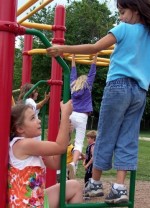Are We Ready to Ditch Rules for Recess?

Are we willing to ditch rules for school playgrounds?
During his school recess, back when he was in the third grade, my older son invented a game in which he was the proprietor of a store, prompted by the presence of the little take-out-style window that was part of the playground equipment at his school. Some other kids joined him and before long there was a network of employees, bosses, customers and — probably inevitably — robbers trying to break in and cops chasing them down (while my son, not a fan of running particularly, just tried to sell some hamburgers or ice cream or deal with his workers). Before too long, the game was shut down by the playground minders.
No cops and robbers allowed.
No one wants kids to get hurt or to be bullied, surely. But zero-tolerance rules on playgrounds have their by-now-not-unfamiliar side effect, which is that children become bound and hampered and — some say, and I agree — held back and infantalized by elaborate, inflexible rules. For example, you can (carefully) walk up the steps (one at a time) and then slide down the molded plastic slide, but you can’t take a running start and dash up the slide on your sneakers. Which, by the way, you must wear for recess; no sandals allowed.
In lower primary school my sons attended, it wasn’t uncommon for recess to be canceled (in favor of “indoor” recess), not just for bad weather like freezing cold and rain, but for those days after the bad-weather days, too. Why? Puddles on the playground. Sand on the blacktop. Someone could get hurt. What?!
I write this today because this morning I read a piece called Recess without Rules, in Atlantic.com. It’s by Jessica Lahey, a former teacher and author of the forthcoming book, The Gift of Failure: How the Best Parents Can Learn to Let Go So Their Children Can Succeed. She writes about a primary school in Aukland, New Zealand that has a no-rules policy for their playground, and has found that it’s cut down on problems between children such as bullying. The school was, at first, participating in a university study about free play, and it worked so well they ripped up the old rules and let ‘em at it. Scooters? Skateboards? Sure. Climbing? Go for it! Wonder of wonders, the school found out: you leave kids to their own devices as they play, and they work out their issues on their own. Bumps and bruises may increase, but that — this school has discovered — is a small price to pay for the benefits of free play, which are by now legendary.
Actually legendary. As in, “back in my day…” You know the stories. You have the stories. I’ve written the stories. I lived them, too.
So is our response to this New Zealand school a round of high-fives, but… (but it wouldn’t work here, it couldn’t work here)? That was what Lahey surmises — correctly and sadly in my opinion — in her Atlantic piece. That yes we’re all nostalgic for the days of unfettered play (and “dangerous” playground equipment), but even nostalgia, and even its companion — feeling sorry that our kids don’t have that freedom and can’t enjoy its benefits of greater independence and self-confidence — isn’t going to compel the greater number of us to push for any changes.
Because it’s all well and good to think our kids would benefit from free play and climbing and tussling and working out their issues together; it’s quite another to let them do that. Why? Because then our child might get hurt. It’s fine to think about how it’s character-building to let kids tumble off a monkey bar; it’s not fine (for many of us) to think of our kid doing the tumble.
And our schools know this, as Lahey points out:
I’ve seen some of these otherwise enthusiastic parents get overwrought and litigious when their own child suffers an injury during the school day. I’ve seen principals shrug their shoulders and explain that overly restrictive playground rules are simply the rules parents demand and, consequently, what schools must implement. [emphasis mine]
Recently, I got into a conversation with parents in my school district on a Facebook page. Someone wondered — on the day of one of our recent snowstorms here in the Northeast — why our schools didn’t employ early dismissal to get everyone home before roads got bad. Now, I know this isn’t about free-play recess, but hear me out. A few parents said that they’d driven to their children’s schools in the snow to pick them up early — safer, they maintained, than having them wait and take the bus home. I countered that I thought it was far safer to let them all take the bus, buses being safer on snowy roads than your SUV or mine. Especially if it’s all our cars sliding into the lots of our schools, all of which sit in residential neighborhoods.
While some parents in this discussion might have heard that buses, statistically, are safer, statistics mean nothing — to them — when it comes to their own kids.
I was furious back when my child, in the third grade, had his imaginary store shut down. I’m sad that this same kid, now in sixth grade, doesn’t even have recess any longer. Yes, I’m glad that safety is important to the people who are responsible for my kids six hours a day, but should that safety always, every single time (even when “safety” means “no bruises, no playing in mud, no fighting”) trump the one thing our kids have so precious little of: freedom?
What do things look like on your kids’ playgrounds?